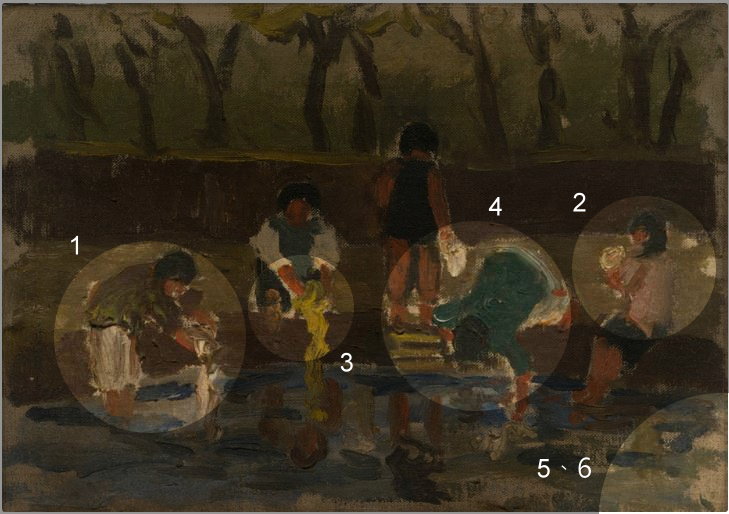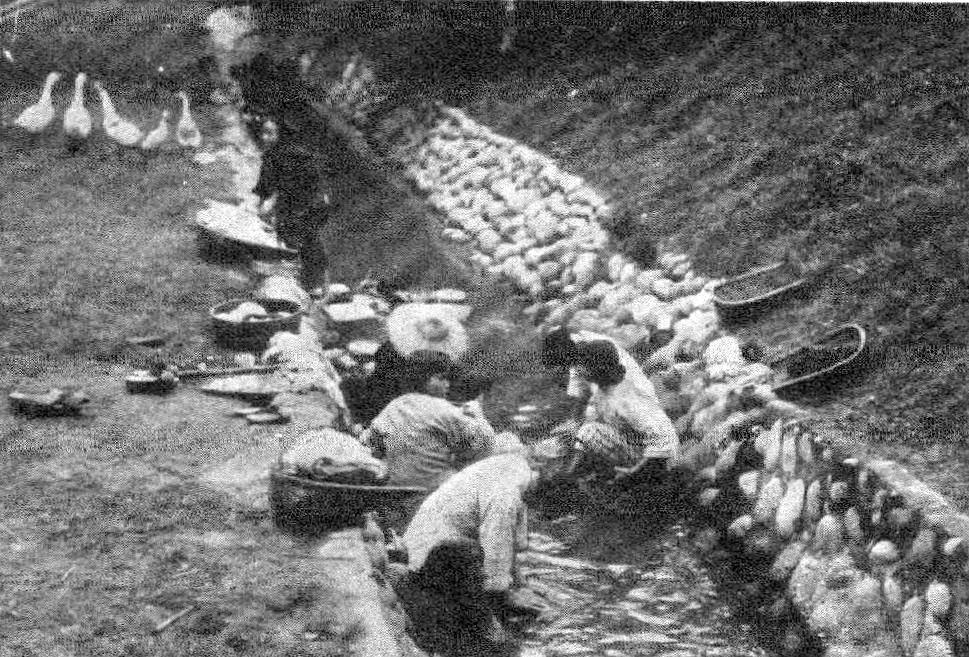洗衣
為提供使用者有文書軟體選擇的權利,本文件為ODF開放文件格式,建議您安裝免費開源軟體 ([連結])

洗衣
Doing Washing
洗濯
年代不詳, 畫布油彩, 23.9×33.7cm
Date unknown, oil on canvas
制作年不詳,画布油彩
清淺的水流畔,婦人們蹲低身子使勁地搓揉衣衫,如鏡的水面上倒映出勤勞的身影。村里新聞、家庭瑣事,也趁著肩並肩的洗濯勞動,在這個小小角落裡流通交換。而在她們身旁,跟著母親來到洗衣場的孩子,正要踩進水裡恣肆嬉戲。
Immersed in the task of handwashing laundry, women crouch over the edge of a riverbank, their reflections mirrored in the surface of the clear shallow water. Working next to each other, they share and exchange tidbits of local news and neighborhood gossip. Children who have come with their mothers wait along the water’s edge, ready to jump in and splash around.
浅瀬の岸辺にしゃがみ込んだ女性たちが、力をこめ衣服をもみ洗いしています。働く姿が鏡のような水面に、映し出されています。村での出来事や、家でのあれこれ。肩を並べて洗濯しながら、川の片隅で情報を交換しているのでしょう。傍らには母親について洗濯場に来た子供もいて、川に入って遊ぼうとしています。
水邊浣衣的場景是臺灣鄉土的親切記憶,凝視這幅畫,彷彿能聽見水花潑濺,在岸上的談笑聲中輕輕響起。
This painting rekindles fond memories of washing clothes by the riverside, memories which are shared by many in Taiwan’s elder generation. Looking at this painting, you can almost hear the women’s chatter and laughter mingled with the splashing of the water.
水辺で洗濯をする場景は、台湾の懐かしい記憶の一つです。この絵を見ていると、岸辺で談笑する声に交じって、バシャバシャとはねる水の音が聞こえてくるようです。

1.水邊浣衣
Washing clothes by the riverside
水辺での洗濯
在自來水設施與地下水井還不普及的年代,洗滌衣物的用水,多半得仰賴溪流、湖泊或人工圳道。婦女齊集在聚落的水源地搓洗衫褲,在昔日的臺灣鄉間隨處皆有,而在嘉義製材工場內大片的老杉池,也能見到同樣的浣衣景象。
Before indoor plumbing and underground wells became virtually ubiquitous, water used for washing clothes was mostly provided by streams, lakes, or man-made canals. Women throughout rural Taiwan would congregate at natural water sources near their homes to wash clothes by hand. In Chiayi, women could be seen doing so at the local sawmill’s old log pond.
地下水をくみ上げる井戸や水道設備がまだ普及していなかった頃、洗濯といえば川や湖、用水路が頼りでした。その昔、女性たちが水辺に集まって衣服をもみ洗いする姿は、台湾の田舎の至る所で見られました。嘉義の製材工場にあった大きな杉池でも、洗濯をする光景が見られました。
2.不只是洗濯
More than just washing clothes
洗濯しながら…
「男主外,女主內」的傳統觀念當中,女性被分配的工作經常是留在屋子裡,負責各種家事勞動。不過,集合在一起洗衣服,反倒為早期臺灣的婦女群體創造了難得的互動場域,使她們有機會走出家門,與街坊鄰居接觸、交流。
In keeping with the traditional notion that “a woman’s place is in the home,” the various domestic chores assigned to women did indeed normally keep them indoors. However, washing clothes brought Taiwanese women to a communal space in which they could freely interact. It also created an opportunity—otherwise rare at the time—for them to leave the confines of home and enjoy the company of neighbors and friends.
「男は外、女は内」という伝統的な観念の中にあって、家に留まり家事をするのが女性に与えられた仕事でした。しかし、皆が集ってする洗濯は、往時の台湾人女性たちが築いた大切な交流の場でした。洗濯を外出の理由にして、ご近所さんたちに会い、おしゃべりを楽しむことができたのです。
3.洗衣服:從傳統到現代
Washing clothes: from past to present
洗濯─伝統的手法からの近代化
日治時期的臺灣,隨著人口與產業急遽成長,水源汙染日益嚴重,逐漸有許多輿論站在現代衛生角度,抨擊水邊浣衣是應當改革的風俗。與此同時,採用西洋方法的「洗濯屋」開始出現在城市當中,成為日後臺灣洗衣業的濫觴。
During the Japanese era, the rapid growth of Taiwan’s population and industries resulted in the devastating pollution of local water supplies. Gradually, in view of modern hygienic standards, some in the public began to vigorously campaign against the practice of washing clothes outdoors. At the same time, new Western-style laundromats began to open for business in cities, marking the birth of what would become a fully-fledged industry.
日本統治時代の台湾では、急激な人口増加と産業の急成長に伴い、水質汚染が日増しに深刻となり、近代的な公衆衛生の観点から、水辺での洗濯は悪習で改めるべきだと批判されるようになりました。ちょうどその頃、西洋風の「洗濯屋」が町中に現れ始め、その後のクリーニング業の起源となりました。
4.臺灣奇景
A quintessential Taiwanese sight
台湾の奇景
對於習慣以井水洗濯的日本人來說,臺灣婦女群聚在河畔浣衣的景象,是一種異地奇觀。當時有許多介紹臺灣風物的「寫真帖」(攝影集),都會拍攝婦人們比肩蹲坐在水邊洗滌衣物的景象,並且將之標舉為殖民地的特色風景。
To the Japanese, who were accustomed to washing clothes with well water, the sight of Taiwanese women washing clothes along riversides had a certain exotic charm. During the colonial period, multiple collections of “photobooks” introducing the society and scenery of Taiwan were published in Japan. These invariably included photographs of women huddled together in small groups along riverbanks, busy handwashing clothes—images which represented quintessential scenes of colonial life.
井戸端での洗濯が一般的だった日本人にとって、台湾人女性が川岸に集って洗濯をする光景は、一種の奇観でした。台湾の風物の数々を紹介した「写真帖」(写真集)には、水辺にしゃがみ込んだ女性たちが肩を並べて洗濯する様子を撮影した写真が、植民地ならではの光景として掲載されています。

下田將美,《南島經濟記:附.朝鮮》(東京市:大阪屋号書店,1929),頁129後之夾頁。
國立台灣大學授權。
Shimoda Masami, Southern Islands Economic Report: Appendix—Korea. Tokyo: Osaka Bookstore, 1929, inserted after page 129.
下田将美,『南島経済記:附・朝鮮』(東京市:大阪屋号書店,1929),p.129後の綴じ込み。
http://photo.lib.ntu.edu.tw/pic/db/detail.jsp?dtd_id=32&id=30501&8&pk=seq&showlevel=2
5.浣衣主題的畫作
Women washing clothes as a subject for painters
洗濯が主題の画作
水邊浣衣既然是早期臺灣的一種特色風景,自然也成為在地畫家群體的創作主題。李石樵、李梅樹、藍蔭鼎等美術史上的名宿,皆曾描繪過類似場景,所有這些作品,都表現了畫家對於家鄉土地、社會人群及其生活圖景的關注。
A characteristic scene of early Taiwanese life, women washing clothes at water’s edge naturally became a popular subject for local painters. Several of Taiwan’s renowned early artists, including Lee Shih-chiao, Li Mei-shu, and Lan Yinding created paintings of such scenes. These works speak to the great love these artists felt for their home land and the interest they took in society and communal life.
水辺での洗濯は、往時の台湾独特の光景だったことから、自然と画家たちの創作テーマの一つになりました。李石樵や李梅樹、藍蔭鼎など、美術史に名を残す大家も同じような場景を描いています。いずれの作品にも、故郷とその地で暮らす人々、郷土の生活風景への思いが表現されています。

李梅樹,《河邊清晨》,畫布油彩,91x116.5cm,1970。
Li Mei-shu, Morning at the Riverside, oil on canvas, 91 x 116.5 cm, 1970.
李梅樹,『河辺清晨』,画布油彩,91x116.5cm,1970。
6.畢沙羅,《洗衣婦》
Pissarro: The Laundry Woman
ピサロ『洗濯をする女』
西洋美術史上,也有許多作品以洗衣婦人為主題。例如,法國的印象派大師畢沙羅(Camille Pissarro),就喜歡描繪鄉間婦女的洗衣場景。在陳澄波所收集的美術明信片當中,也有一幅畢沙羅的畫,描繪女性俯身在水桶裡搓洗衣物的場景。
Numerous works from the Western art canon also feature women handwashing clothes. For example, the French Impressionist painter Camille Pissarro enjoyed painting rural women tending to laundry. An image of The Laundry Woman, a painting of this genre by Pissarro, was found among Chen’s collection of artistic images. It depicts a woman bent over a large water bucket, scrubbing clothes clean.
西洋美術の作品にも、洗濯する女性を主題とした絵画が多数存在します。一例を挙げると、フランス印象派の大家ピサロ(Camille Pissarro)は、田舎の女性たちが洗濯をする場面を好んで描きました。陳澄波が収集していた絵画の絵葉書の中にも、ピサロの絵葉書が1枚あります。女性が身をかがめて、水桶に入れた洗濯物をもみ洗いする様子が描かれています。

洗衣婦女
The Laundry Woman
洗濯をする女
中央研究院臺灣史研究所檔案館授權。
